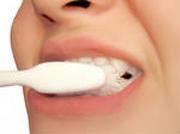
Throughout your life you end up having 2 completely different sets of teeth. The initial set is the baby teeth (deciduous teeth) that eventually fall out. They are whiter, softer, and less sturdy than adult teeth. Hence, they tend to wear out much faster than permanent teeth, but they also fall out to make room for them. Making sure that there's enough space in the vacancy caused by a lost baby tooth is important for healthy adult teeth. Excellent crowns and bridges were made by the Etruscans in the 7th cent. B.C. At about that time, teeth were being extracted in Asia Minor as a cure for bodily ills and diseases. Skills achieved by the Etruscans, Phoenicians, Egyptians, Greeks, and Romans were largely lost during the Middle Ages, when barbers and roving bands of charlatans practiced unskilled dentistry at marketplaces and fairs. Abulcasis, a Spanish Moor, was one of the few in his time who studied dental surgery. The permanent teeth are the second set of teeth that will last the rest of your life. They tend to be more yellow (and not just because of coffee) and are extremely hard. The final set of teeth is made up of 32 teeth, or 16 on each jaw. There are two central incisors for biting, two lateral incisors for biting, two canines for tearing and cutting, four premolars for chewing, and six molars for chewing.
Tooth loss is something no one looks forward to. If you lose one or more teeth, you have a number of options, one of which is dental implants. You owe it to yourself to be informed as possible about these options. With this in mind, we've created this section on dental implants. Begin learning more about dental implants for tooth replacement exacltly now! Implants are great for replacing missing teeth. It is important that you have enough bone in the area of the missing teeth for the implants to be attached to. Implants are not only used to replace one tooth, but rather people missing most, if not all, of their teeth benefit greatly as well. Implants are increasingly being used to replace certain types of bridges and removable partial dentures. Implants are surgically placed in your jaw bone while under anesthesia. It is a very time consuming procedure when having many implants placed. As this procedure is surgical, it is very important to research and find a well credited cosmetic dentist that you are comfortable with. For some people there are varying degrees discomfort or pain, which subsides in a couple of days. As with similar types of surgery, bruising and minor swelling might also develop shortly after the procedure.
Dentures, also known as false teeth, are the primary topic in this section of our site. Here, you can learn how the procedure is performed, what dentures cost and the advantages and disadvantages of having them. The setting up dentures procedure begins with a wax bite impression of your mouth that will give your dentist exacting measurements. A try-on appointment will fine tunes color, shape, and custom-fit. After your final dentures are fabricated, they will be placed and informed of their required care. The main component of dentures is acrylic resin molded over the top of various combinations and paterns of metal. In oreder to use dentures all of the teeth in the top or bottom or both top and bottom of the mouth are removed. It is recomended that after the removal of the necessary teeth that the patient wait at least a month to have the dentures fit to the mouth. The waiting period allows for proper healing in the mouth to take place.
This section of our cosmetic dentistry information site provides you with some background into dental veneers, both composite veneers and porcelain veneers. Dental veneers, sometimes called tooth veneers, can be used to correct both color and shape problems. There are several corrections that you can make to the color of your teeth as well as the shape of your teeth! Some of the causes of tooth discoloration are staining, aging, chemical damage, disease, medication, and genetics. Dental Veneers (Tooth Veneers) are used to correct both the color and the shape of teeth. Veneers provide a durable solution to the color and shape problems that are common to so many people. Veneers are applied to fronts or visible areas of the teeth. The enamel (outside layer of the tooth) is ground down or reduced by just fractions of a milimeter in order to allow for the thin (contact lense thickness) veneer to be permanently attached to the tooth. Dental veneers (sometimes called porcelain veneers or dental porcelain laminates) are wafer-thin, custom-made shells of tooth-colored materials designed to cover the front surface of teeth. These shells are bonded to the front of the teeth changing their color, shape, size or length and resulting in an improved appearance.
Bonding is a composite resin filling placed in the back teeth as well as the front teeth. Composites are the solution for restoring decayed teeth, making cosmetic improvements and even changing the color of your teeth or the reshaping of teeth. Bonding will lighten any stains you may have, close up minor gaps and can be used to correct crooked teeth. The resin comes in many shades so that we can match it to your natural teeth. Due to the layers involved, this procedure will take slightly longer than traditional silver fillings because multiple layers of the bonding material are applied. Typically bonding takes an hour to two hours depending on your particular case.
A dental bridge is a false tooth, known as a pontic, which is fused between two porcelain crowns to fill in the area left by a missing tooth. The two crowns holding it in place that are attached onto your teeth on each side of the false tooth. This is known as a fixed bridge. This procedure is used to replace one or more missing teeth. Fixed bridges cannot be taken out of your mouth as you might do with removable partial dentures. In areas of your mouth that are under less stress, such as your front teeth, a cantilever bridge may be used. Cantilever bridges are used when there are teeth on only one side of the open space. Bridges can reduce your risk of gum disease, help correct some bite issues and even improve your speech. Bridges require your commitment to serious oral hygiene, but will last as many ten years or more. You maybe candidate for dental bridges, if you have missing teeth and have good oral hygiene practices, you should discuss this procedure with your cosmetic dentist. If spaces are left unfilled, they may cause the surrounding teeth to drift out of position. Additionally, spaces from missing teeth can cause your other teeth and your gums to become far more susceptible to tooth decay and gum disease.
The classic metal orthodontic braces are the most familiar method of teeth straightening. Consisting of a bracket glued to the front of each tooth and a metal wire connecting them, orthodontic braces usually require several years of wear for effective teeth straightening. They can be uncomfortable, expensive, and embarrassing for older patients. However, they are still the most effective method of teeth straightening and can correct overbites and underbites as well as individual teeth alignment. Lingual braces are similar to classic orthodontic braces but are attached to the backside of the teeth, rather than the front. Although they still have many of the problems of standard braces, they are not visible and may be chosen by adults who do not wish for visible braces. Lingual braces are more expensive than standard braces but the fastest method of "invisible" teeth straightening. The most common method of teeth straightening remains standard orthodontic braces. Archwires, springs, and rubberbands apply pressure to the individual teeth by means of brackets that are glued onto their surface. Regular visits are required to the orthodontist in order to tighten wires as needed and make other adjustments. At each visit, the wires will be tightened slightly to renew pressure and push them toward their intended position. Additional wires, rubberbands, and headgear may be prescribed to help move the teeth into their ideal position as quickly as possible. When the teeth have all been repositioned, the brackets will be removed and a retainer must be worn to prevent relapse for some period of time.

Definition interpretingDental fillings
- Dental fillings are inserted as restorations in the treatment of dental cavities, after drilling out the cavities.
Dental implants
- Dental implants are surgically fixed substitutes for roots of missing teeth. Embedded in the jawbone, they act as anchors for a replacement tooth, also known as a crown, or a full set of replacement teeth.
Dentures
- Removable complete dentures are full-mouth false teeth, which are used when a patient has no teeth left on either the mandibular arch, the maxillary arch, or both.
Veneer
- A layer of tooth-colored material, usually porcelain or acrylic resin, attached to and covering the surface of a metal crown or natural tooth structure.
Anesthesia
- Total or partial loss of sensation, especially tactile sensibility, induced by disease, injury, acupuncture, or an anesthetic, such as chloroform or nitrous oxide.
- Local or general insensibility to pain with or without the loss of consciousness, induced by an anesthetic.
- A drug, administered for medical or surgical purposes, that induces partial or total loss of sensation and may be topical, local, regional, or general, depending on the method of administration and area of the body affected.
Bridge
- A dental bridge is a prosthesis used in place of missing teeth and may be removable or permanently attached.
Dental cavities
- The formation of cavities in the teeth by the action of bacteria; tooth decay.
- Also known colloquially as tooth decay.
Dental crown
- Full-coverage restoration (sometimes incorrectly called a cap) is a prosthetic tooth designed by a dentist and usually created by a lab technician.
Porcelain
- A hard, white, translucent ceramic made by firing a pure clay and then glazing it with variously colored fusible materials.
Stomatology
- The medical study of the mouth and its diseases.
Tooth bleaching
- Also known as tooth whitening.
|